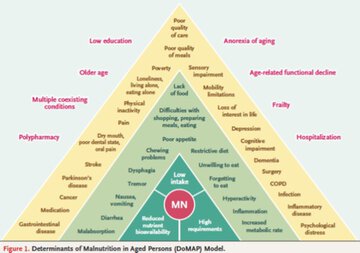Cruz-Jentoft AJ, Volkert D. Malnutrition in Older Adults
N Engl J Med. 2025
Malnutrition should be routinely detected and treated in older patients in any clinical setting - AJ Cruz Jentoft
Summary:
Healthy dietary patterns are associated with longer and healthier lives. Malnutrition is a state of imbalance between the intake or uptake of nutrients and body needs that leads to altered body composition, reduced physical and mental functioning, and impaired clinical outcomes. Malnutrition is an umbrella term that includes obesity, undernutrition, and single nutrient deficiencies, but it has also been used as a synonym for undernutrition. In this article, malnutrition is used to describe undernutrition (protein-energy malnutrition), as defined in the International Classification of Diseases, with emphasis on features that are specific to older adults. In older adults, malnutrition has been shown to carry serious adverse consequences, including physical and cognitive disability, increased complications and poorer outcomes of disease, increased length of inpatient stay, poor quality of life, and increased costs.
Why do you highlight this publication?
Malnutrition (undernutrition) is one of the big geriatric syndromes described many decades ago (Inanition, one of the Big I's). However, most clinicians are unaware of the relevance and prognostic implications of malnutrition when treating older
adults in any clinical setting. In this series on nutrition, the New England Journal of Medicine has opted to include this topic, one of the very few geriatric syndromes reviewed in this major journal. Hopefully, it will help to increase awareness and introduce malnutrition detection and management in mainstream clinical practice.
Publication commented by:
Dr. Alfonso José Cruz Jentoft
Geriatry Department, Head. HURYC
Geriatrics group, IRYCIS



